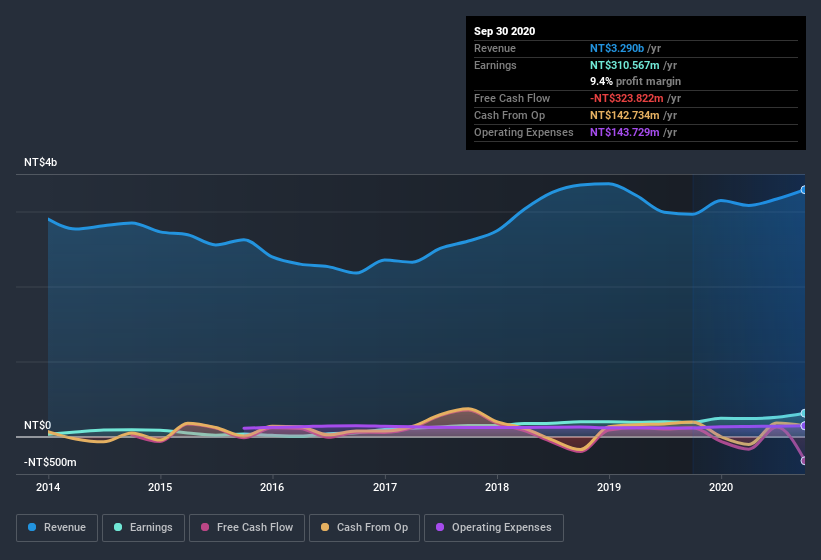- Taiwan
- /
- Electrical
- /
- TWSE:1615
Dah San Electric Wire & Cable (TPE:1615) Is Growing Earnings But Are They A Good Guide?
It might be old fashioned, but we really like to invest in companies that make a profit, each and every year. That said, the current statutory profit is not always a good guide to a company's underlying profitability. In this article, we'll look at how useful this year's statutory profit is, when analysing Dah San Electric Wire & Cable (TPE:1615).
We like the fact that Dah San Electric Wire & Cable made a profit of NT$310.6m on its revenue of NT$3.29b, in the last year. One positive is that it has grown both its profit and its revenue, over the last few years.
View our latest analysis for Dah San Electric Wire & Cable

Of course, when it comes to statutory profit, the devil is often in the detail, and we can get a better sense for a company by diving deeper into the financial statements. Today, we'll discuss Dah San Electric Wire & Cable's free cashflow relative to its earnings, and consider what that tells us about the company. Note: we always recommend investors check balance sheet strength. Click here to be taken to our balance sheet analysis of Dah San Electric Wire & Cable.
A Closer Look At Dah San Electric Wire & Cable's Earnings
In high finance, the key ratio used to measure how well a company converts reported profits into free cash flow (FCF) is the accrual ratio (from cashflow). In plain english, this ratio subtracts FCF from net profit, and divides that number by the company's average operating assets over that period. This ratio tells us how much of a company's profit is not backed by free cashflow.
That means a negative accrual ratio is a good thing, because it shows that the company is bringing in more free cash flow than its profit would suggest. That is not intended to imply we should worry about a positive accrual ratio, but it's worth noting where the accrual ratio is rather high. To quote a 2014 paper by Lewellen and Resutek, "firms with higher accruals tend to be less profitable in the future".
Dah San Electric Wire & Cable has an accrual ratio of 0.25 for the year to September 2020. We can therefore deduce that its free cash flow fell well short of covering its statutory profit. In the last twelve months it actually had negative free cash flow, with an outflow of NT$324m despite its profit of NT$310.6m, mentioned above. We saw that FCF was NT$113m a year ago though, so Dah San Electric Wire & Cable has at least been able to generate positive FCF in the past.
Our Take On Dah San Electric Wire & Cable's Profit Performance
Dah San Electric Wire & Cable didn't convert much of its profit to free cash flow in the last year, which some investors may consider rather suboptimal. Because of this, we think that it may be that Dah San Electric Wire & Cable's statutory profits are better than its underlying earnings power. But the good news is that its EPS growth over the last three years has been very impressive. At the end of the day, it's essential to consider more than just the factors above, if you want to understand the company properly. With this in mind, we wouldn't consider investing in a stock unless we had a thorough understanding of the risks. Case in point: We've spotted 4 warning signs for Dah San Electric Wire & Cable you should be mindful of and 2 of these bad boys are a bit unpleasant.
This note has only looked at a single factor that sheds light on the nature of Dah San Electric Wire & Cable's profit. But there are plenty of other ways to inform your opinion of a company. Some people consider a high return on equity to be a good sign of a quality business. While it might take a little research on your behalf, you may find this free collection of companies boasting high return on equity, or this list of stocks that insiders are buying to be useful.
When trading Dah San Electric Wire & Cable or any other investment, use the platform considered by many to be the Professional's Gateway to the Worlds Market, Interactive Brokers. You get the lowest-cost* trading on stocks, options, futures, forex, bonds and funds worldwide from a single integrated account. Promoted
New: Manage All Your Stock Portfolios in One Place
We've created the ultimate portfolio companion for stock investors, and it's free.
• Connect an unlimited number of Portfolios and see your total in one currency
• Be alerted to new Warning Signs or Risks via email or mobile
• Track the Fair Value of your stocks
This article by Simply Wall St is general in nature. It does not constitute a recommendation to buy or sell any stock, and does not take account of your objectives, or your financial situation. We aim to bring you long-term focused analysis driven by fundamental data. Note that our analysis may not factor in the latest price-sensitive company announcements or qualitative material. Simply Wall St has no position in any stocks mentioned.
*Interactive Brokers Rated Lowest Cost Broker by StockBrokers.com Annual Online Review 2020
Have feedback on this article? Concerned about the content? Get in touch with us directly. Alternatively, email editorial-team@simplywallst.com.
About TWSE:1615
Dah San Electric Wire & Cable
Engages in the production and sale of power cables, communication cables, electronic wires, and bare copper wires.
Outstanding track record with flawless balance sheet.
Market Insights
Community Narratives



